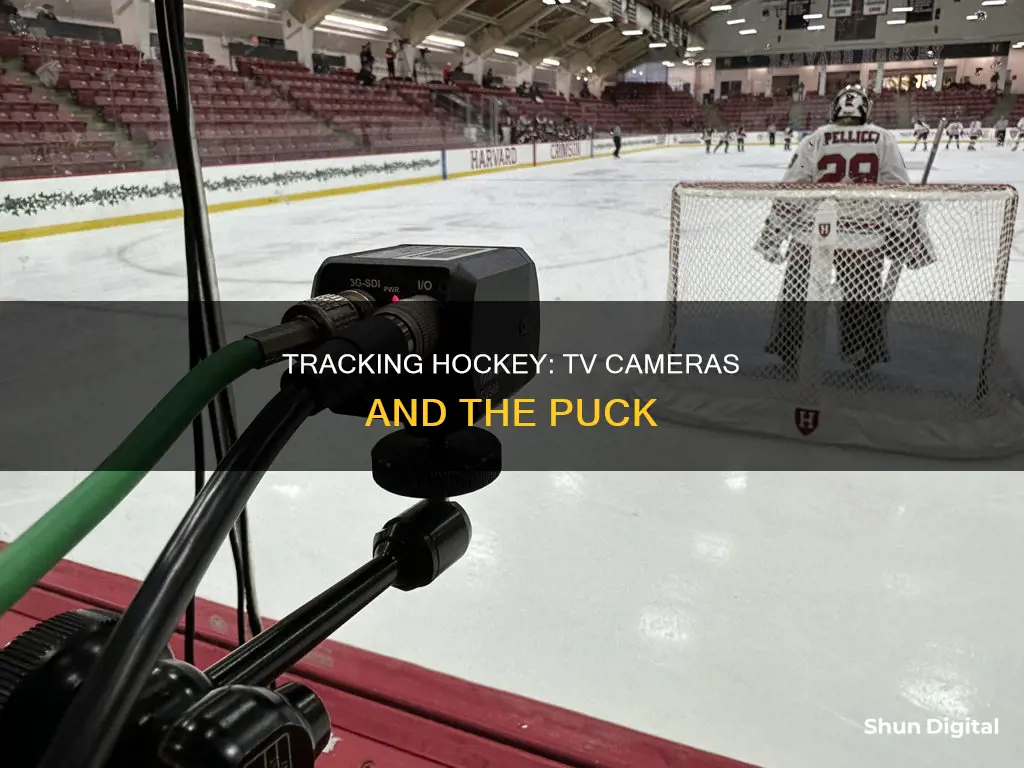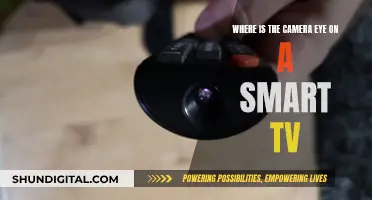
Tracking the fast-moving puck in a hockey game is a challenging task. Broadcasters employ a range of sophisticated tools and technologies to ensure that every moment of the game is captured for audiences. This includes optical tracking systems, computer vision algorithms, infrared technology, specialised equipment, and skilled camera operators. Optical tracking systems consist of multiple cameras placed around the rink to track the puck's movement. Infrared technology detects the puck's heat signature, while computer vision algorithms analyse footage in real-time. Puck trackers or follow cams are specialised cameras designed to keep the puck in focus. Additionally, skilled camera operators manually adjust the camera movement to capture the fast-paced action. These technologies work together to provide accurate and engaging puck tracking for viewers.
| Characteristics | Values |
|---|---|
| Technology | Optical tracking systems, computer vision algorithms, infrared technology, radar-based systems, antenna-based systems, robotic camera systems, smart camera technology |
| Camera Operators | Skilled camera operators work with the technology to capture the right shots at the right time |
| Calibration | Camera systems are meticulously calibrated before each game to ensure accurate tracking |
| Accuracy | Modern systems can typically track the puck within a few inches |
| Limitations | Obstructed views, fast movements, and high speeds can pose challenges |
| Applications | TV broadcasts, gambling options, analytics, and statistics |
What You'll Learn

Optical tracking systems
Advanced computer algorithms are then used to analyse these images, determining the puck's location and speed in real-time. While optical tracking systems offer highly accurate data, they are more intricate and costly to implement than radar-based systems.
The NHL, for instance, utilises an optical tracking system called NHL Edge, which is operated by SMT, the league's puck and player tracking partner. SMT's initial sensor-fused puck was used for a few days in the 2020-21 NHL season before standard non-tracking pucks were reinstated due to issues with how the high-tech puck glided on the ice. The following season, a re-engineered version of the puck was introduced, featuring LEDs closer to its top and bottom layers, allowing for a broader distribution of infrared light to reach the in-venue optical cameras. This enhancement results in faster and more accurate puck-tracking statistics and graphics for the league and its media partners.
Pairing Apple Watch with Camera: A Simple Guide
You may want to see also

Computer vision algorithms
One approach to puck tracking utilizes a combination of contour fitting, correlation filters, and motion estimation techniques. This method can detect and track pucks in both controlled moving and free-moving states. By incorporating state-of-the-art online learning correlation filters, the system can effectively track low-texture pucks. Additionally, a template-based online learning re-identification phase is employed to address the challenge of tracking nearly invisible high-speed pucks after shooting actions.
Another technique proposed in research involves using three types of information from ice hockey video recordings: gray-level thresholding, adaptive temporal thresholding, and trajectory constraints. This method, developed by Yakut and Kehtarnavaz, successfully tracks ice hockey pucks and has been compared with table tennis broadcast video sequences to demonstrate its effectiveness.
The algorithms play a crucial role in analyzing video footage in real-time, allowing the system to detect the puck's position and predict its trajectory accurately. This enables broadcasters to generate on-screen graphics, such as the iconic blue glow, that enhance the viewing experience and provide valuable insights for fans, commentators, and teams.
The development of computer vision algorithms for hockey puck tracking has been an ongoing process, with continuous improvements being made to enhance the accuracy and reliability of the technology. These advancements have revolutionized the way fans engage with the sport, providing a deeper understanding of the gameplay and enabling broadcasters to deliver captivating and informative content.
Camera Eclipse Viewing: Is It Safe?
You may want to see also

Infrared technology
In recent years, the NHL has continued to experiment with infrared technology in puck tracking. Sportvision, the company behind FoxTrax, has developed a new system that uses infrared cameras to track a puck with infrared emitters. This system collects data from the puck thirty times a second and can be used to generate advanced analytics, such as shot speed and skater speed, which can be displayed to viewers as an overlay during a game.
The latest generation of NHL pucks feature six circles on both sides, covering tubes that allow infrared cameras to connect the puck with a tracking system. This technology has been designed to not affect the puck's glide or feel, addressing issues encountered in previous attempts to track pucks with microchips.
Apple Watch 5: Camera Location and Functionality
You may want to see also

Puck trackers
Optical Tracking Systems
Optical tracking systems consist of multiple high-speed cameras strategically placed around the rink. These cameras capture images of the puck in flight and, using computer vision algorithms, analyse the footage in real time to determine the puck's location, speed, and trajectory with great accuracy.
Infrared Technology
Some puck trackers are equipped with infrared sensors that detect the puck's heat signature. This technology enables the cameras to easily follow the puck's movement, even in low-light conditions.
Antenna-Based Systems
Antenna-based systems are a newer technology that employs a network of antennas mounted around the rink. These antennas track the location of a tiny chip embedded in the puck and transmit the data to a central computer, which generates graphics for broadcasters and replays for referees.
Radar-Based Systems
Radar-based systems use radar sensors mounted around the rink to track the puck's location in real time. While these systems can be accurate, they are not perfect and may miss data when the puck is obscured by players or other objects.
Smart Camera Technology
Smart camera technology allows cameras to be programmed to automatically follow the action, eliminating the need for human operators. This technology enables more dynamic shots and angles, enhancing viewers' understanding of the game.
Intoxalock's Cameras: Are They Really Watching You?
You may want to see also

Skilled camera operators
The role of camera operators in hockey broadcasting goes beyond simply operating the camera. Their expertise and quick reflexes enable them to anticipate the action, adjust their camera angles swiftly, and work in tandem with the tracking systems. This ensures that even during high-speed shots or deflections, the camera remains focused on the puck.
Camera operators also play a crucial role in coordinating their movements with other members of the camera crew. Effective communication within the team ensures that all angles are covered and that the most important moments of the game are captured from the best possible vantage points.
In addition to their technical skills, camera operators need to possess a deep understanding of the game. This includes knowing when and where to expect crucial plays, as well as being able to make split-second decisions on the right shots to capture. Their ability to work in sync with the technology and other crew members ensures a smooth and captivating broadcast for viewers.
The role of the camera operator is particularly challenging due to the fast-paced and unpredictable nature of the game. The small size of the puck and its rapid movement can make it difficult to track, even for the most experienced operators. However, with their expertise and quick reflexes, skilled camera operators ensure that viewers at home never miss a crucial moment of the game.
Sanyo TV Camera: Fact or Fiction?
You may want to see also
Frequently asked questions
TV cameras use a combination of advanced technology and skilled camera operators to track hockey pucks. Optical tracking systems, computer vision algorithms, infrared technology, specialised equipment, and experienced camera operators all work together to capture the fast-paced action of the game.
There are several technologies used to track hockey pucks, including optical tracking systems, radar-based systems, antenna-based systems, and infrared technology. Optical tracking systems use multiple cameras placed around the rink to track the puck's movement. Radar-based systems use radar sensors to track the puck's location in real time. Antenna-based systems use a network of antennas to track a chip embedded in the puck. Infrared technology detects the heat signature of the puck, making it easier for cameras to follow.
The cameras used in hockey broadcasts are highly accurate and can follow the puck with great precision. Modern tracking systems can adjust to fast-speed shots, deflections, and obstructed views. They can also accurately track the puck in low-light conditions using infrared technology.







